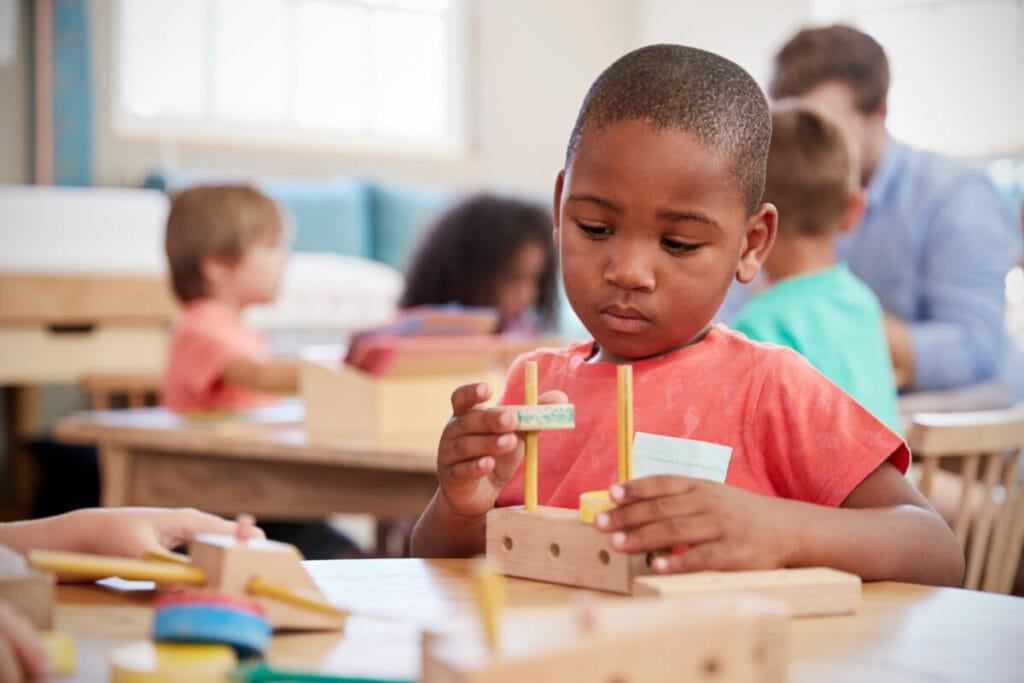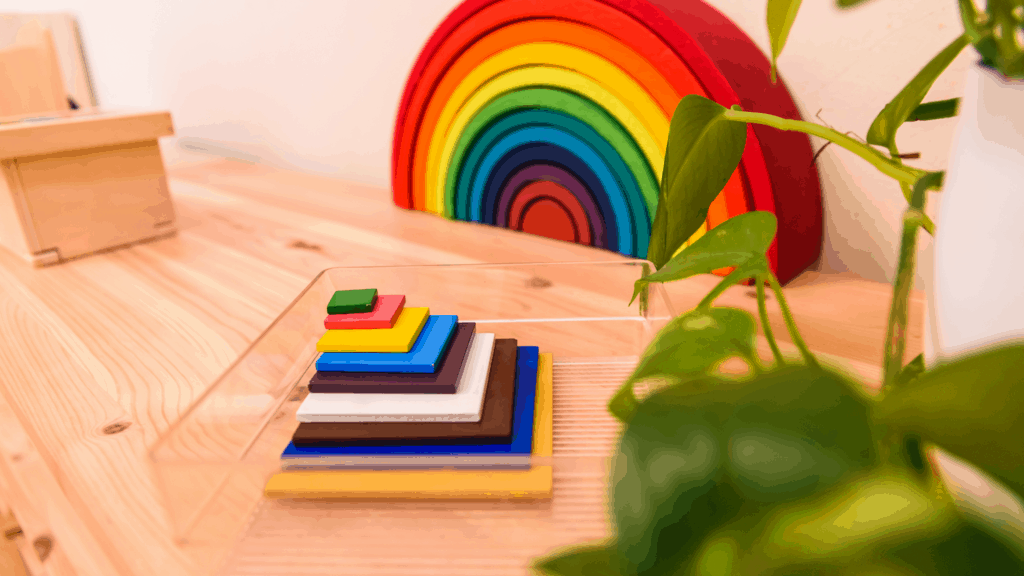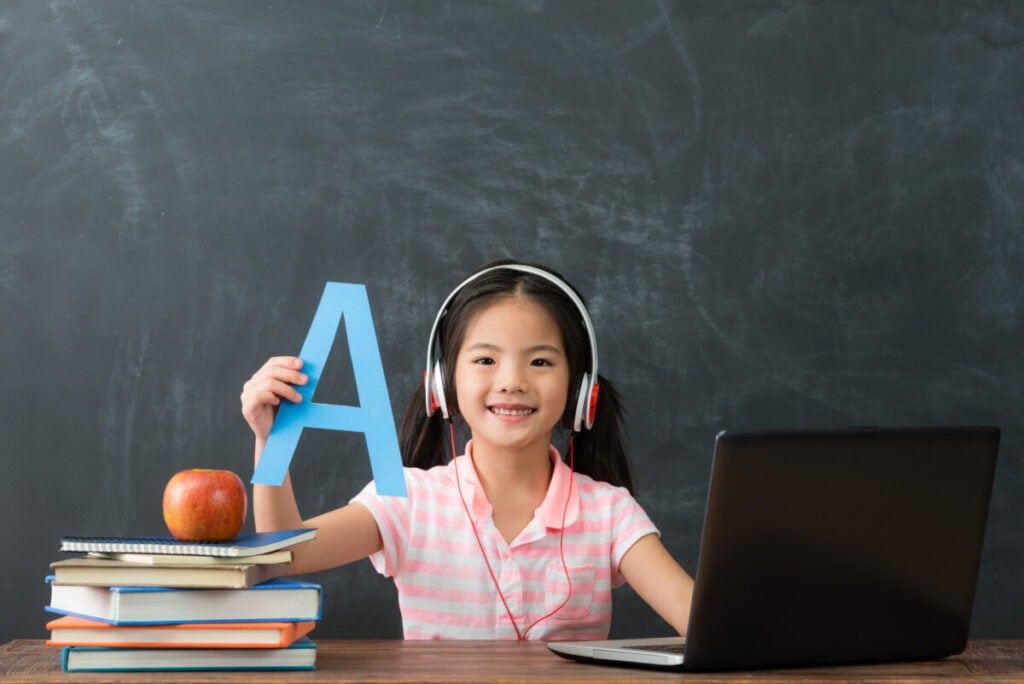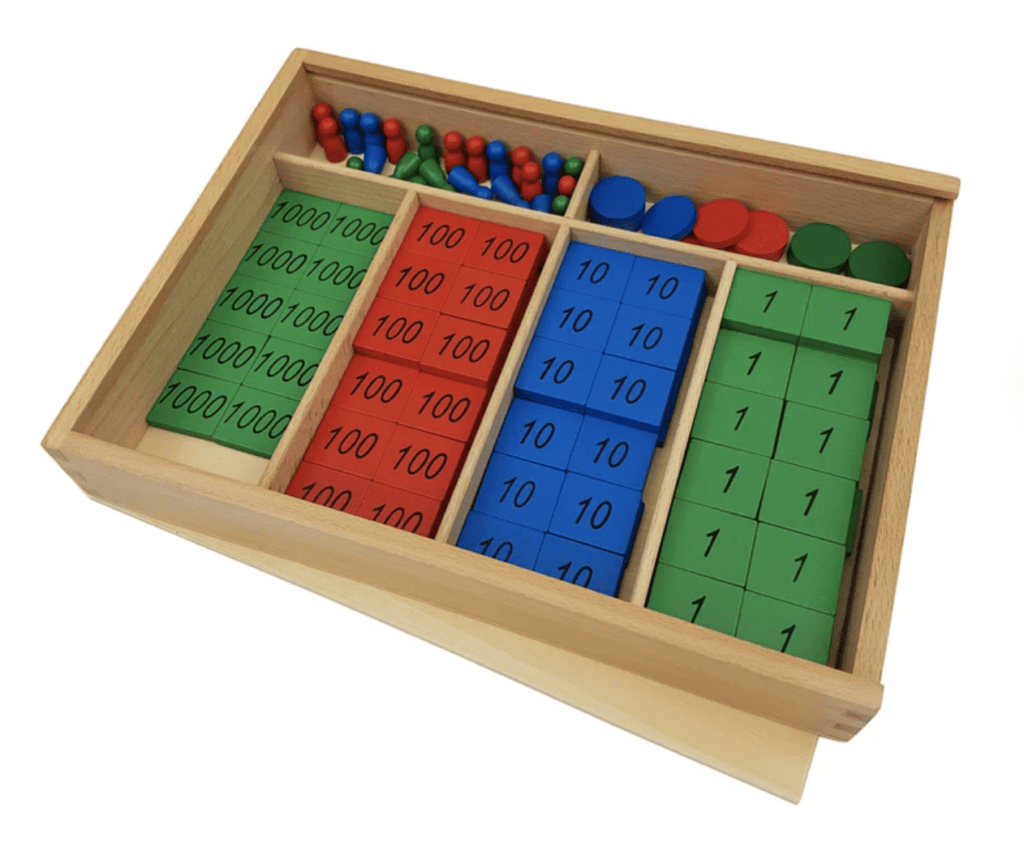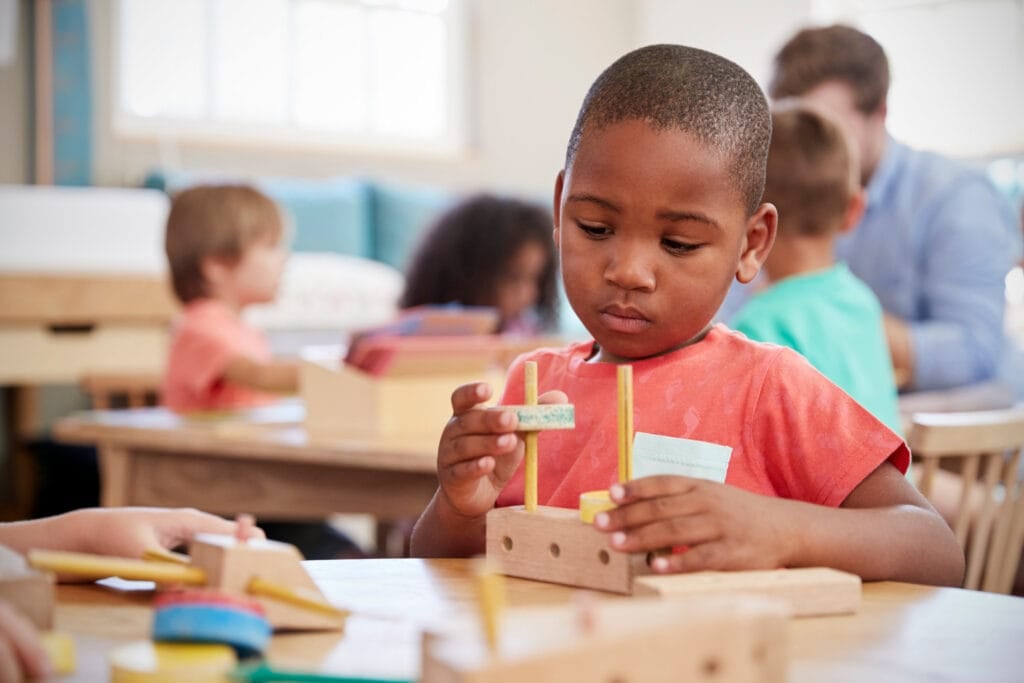The first
At the core of
Sensorial work is incorporated into all of the areas of study found in the Montessori curriculum. It is a key component of the “whole-child” approach that makes
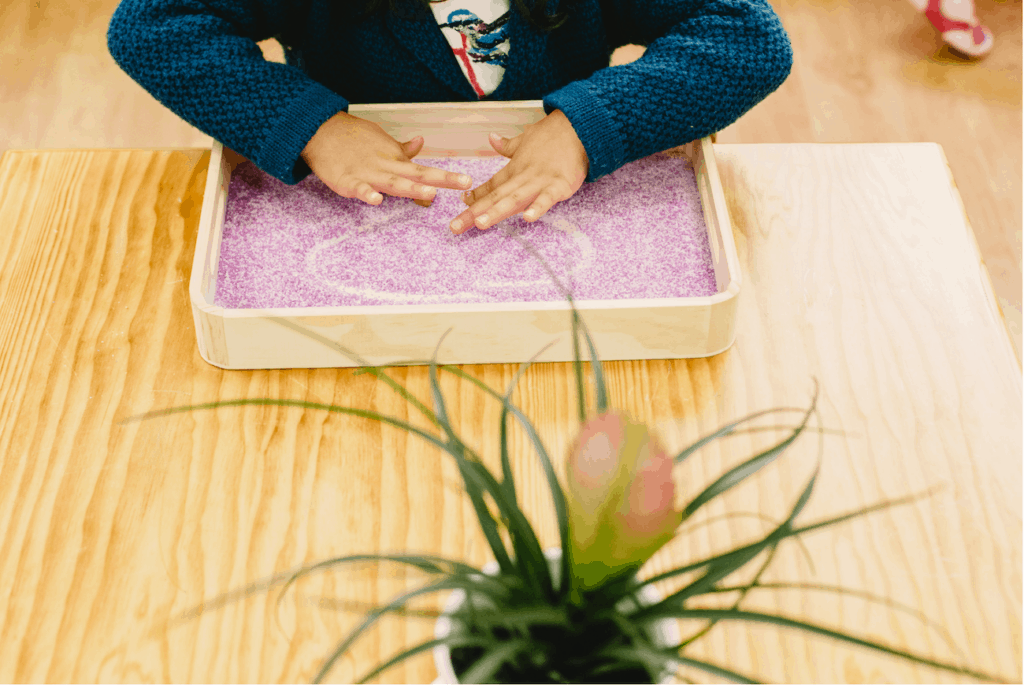
What is Sensorial Work?
The child himself leads the Montessori Method of education. The classrooms of Montessori are open concept and consist of five primary areas for learning. These areas all work together to teach both life skills and academic concepts. While sensorial work is considered one of the five
The five learning areas in a Montessori classroom are:
- Practical Life
- Culture
- Language
- Math
- Sensorial
At the very core of Maria
“The senses, being explorers of the world, open the way to knowledge….the number of different objects in the world is infinite, while the qualities they possess are limited. These qualities are therefore like the letters of the alphabet which can make up an indefinite number of words. If we present the children with objects exhibiting each of these qualities separately, this is like giving them an alphabet for their explorations, a key to the doors of knowledge….This ‘alphabet’ of the outer world has an incalculable value…..Everything depends on being able to see and on taking an interest.”
– Dr. Maria Montessori, The Absorbent Mind (183-184)
While the sensorial area exists on its own, you will find plenty of sensory materials in each of the other areas in the room. This work is vital to a child understanding how he relates to his environment and figuring out how to engage and interact with it appropriately.
In the
Each of the five senses is engaged in its own way to create an experience that the child can translate to their real-world surroundings. Sometimes, the senses are used in coordination with each other, further enhancing the child’s awareness and relationship with their environment.
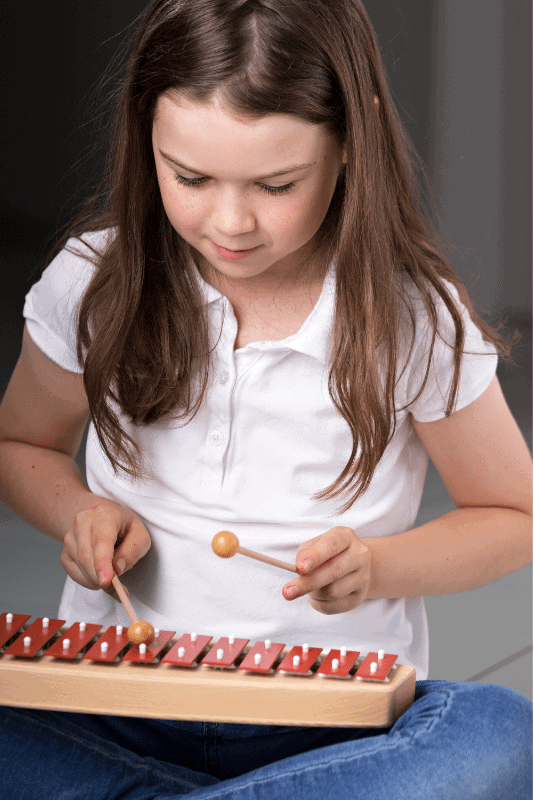
Sensorial work is done in a controlled environment with controlled levels of error, so a child may safely explore and learn specific comparisons and similarities about his environment through his senses.
The area of sensorial work is so thorough, Dr.
- Visual work- The purpose of visual work is for children to be able to categorize and notice the differences and similarities between objects that they see.
- Tactile work- Using the sense of touch, these exercises are focused intently on a child’s fingertips, mainly on the right hand. Focusing on using this sense with such a small part of the body, the feel of an object is enhanced.
- Baric work- Pressure and weight are explored in this category of sensorial work, giving a child critical ways of thinking about and understanding objects around them.
- Thermic work- Within thermic exercises, children are taught to distinguish temperature and develop their sense of temperature.
- Auditory work- The sense of hearing is exercised in this category, helping children differentiate between different sounds and heightening their ability to notice variations in sound.
- Olfactory work- Focusing on a child’s sense of smell, this work helps with a child’s ability to differentiate between different scents.
- Gustatory work- Children explore their sense of taste in these exercises and learn the differences in how things taste.
- Stereognostic work- Sometimes referred to as the sixth sense, or muscle memory, this work develops a child’s ability to recognize or characterize an object without sight, taste, smell, or sound.
Sensorial work plays a vital role in the development of the whole child and how they perceive, interact with, and experience the world around them, setting them up for success in further education, life, and well-being.
Sensorial Activities Contribute To Child Development
Sensory learning and sensory play are critical to a child’s development. Not only have studies shown that sensory exploration builds vital nerve connections in the brain, but it also “supports language development, cognitive growth, fine and gross motor skills, problem-solving skills, and social interaction.” Source: educationalplaycare.com
The refinement of a child’s senses increases their capacity to be adaptable to their surroundings. They are, in fact, engaged in the scientific method. Experiencing a sense, developing a hypothesis, drawing conclusions, and taking action.
An example of how sensory play and education are beneficial to the overall development of a child is something that is learned in auditory exercises. When a child can learn how to identify, categorize, and filter sounds, they are then able to be less distracted by them.
Meaning, that if a child has trouble paying attention or playing with another child due to noises in the classroom, or other sounds around him, auditory sensory work can help train his ears and his brain to “block out” irrelevant sounds and focus on the task at hand.
Texture issues are one of the leading causes of picky eating in children. Sensory exploration as play and learning exposes children to temperature, weight, texture, and more. The more exposure and comfortability a child has with different textures, and the more they can describe them and trust them, the less likely they are to reject foods that have a texture that is foreign to them,
According to Good Start Learning, sensory activities for children:
- build nerve connections in the brain
- encourage the development of motor skills
- supports language development
- encourages ‘scientific thinking’ and problem solving
- involve mindful activities which are beneficial for all children
“Our work is not to teach, but to help the absorbent mind in its work of development. How marvelous it would be if by our help, if by an intelligent treatment of the child, if by understanding the needs of his physical life and by feeding his intellect, we could prolong the period of functioning of the absorbent mind!”
― MariaMontessori , The Absorbent Mind
The extensive sensory experience that is provided in
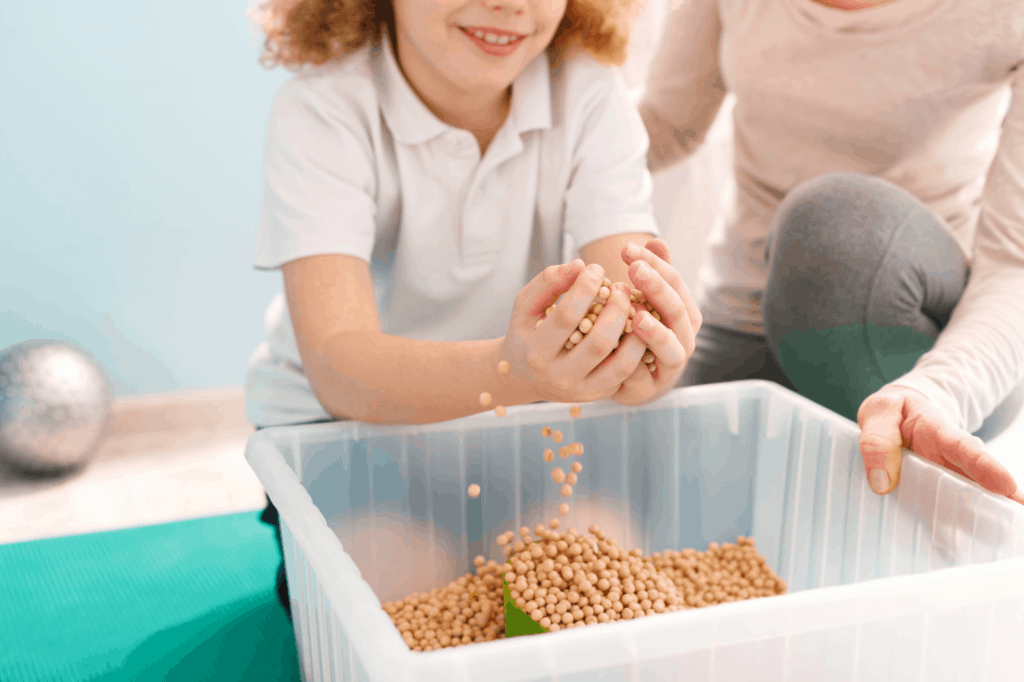
What Sensorial Materials Should Be Used?
Just as important as the work itself, the materials used in Montessori for sensorial work are designed and planned with optimal learning and experience in mind.
Maria
The materials used to refine and strengthen a child’s senses are ones that a child has never seen before, intentionally. Unlike in the personal care area of learning, the goal of sensory work is to create new experiences for a child so that they can relate their knowledge to the world around them as a whole.
Children begin by learning sameness and differences between objects and then move on to quantifying these objects, giving way to the necessary language used to describe them as well.
There is an emphasis on real-world and natural materials in
She believed that “to stimulate children’s imagination, give them real objects and a real understanding of the world. While it is natural for children to be drawn to fantasy, it is the knowledge from the real world that can enrich their ability to imagine and create.” Source: springstonekids.com
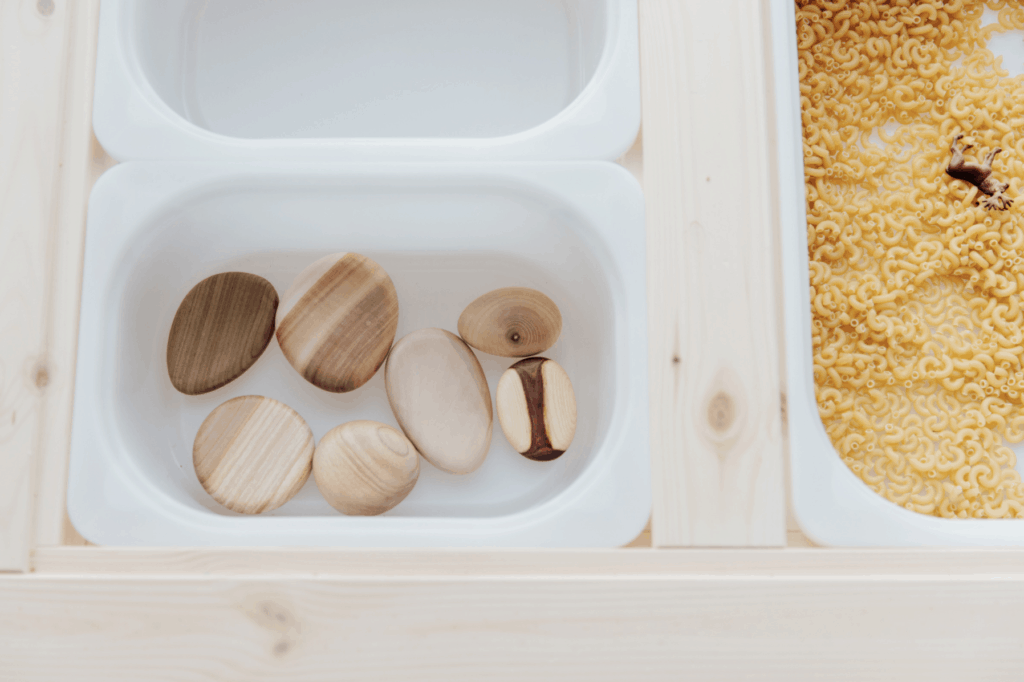
The sensorial objects used in
- Each material is solely focused on a singular sense or quality.
- All materials feature a controlled error, which means that any obstacle or problem can be easily solved by the child himself without adult intervention.
- Sensory materials must be visually stimulating and pleasing to look at. This ensures a child’s natural curiosity and engagement with the material.
- Each set of materials must be complete. There are to be no missing parts so that the child can finish a task and will not be interrupted in their learning.
- Sensorial materials are limited in two ways. First, there is to be only one set in each classroom, which promotes patience, social cues, and turn-taking. Second, not every quality is featured in a material. This gives the child the necessary experience and information while fostering curiosity and interest in learning more on their own.
- Sensory materials are meant to be “materialized abstractions.” Their purpose is to introduce abstract concepts to children in concrete ways.
Sensorial materials are used throughout sensory play and learning, and some have become widely recognized to be signature
Montessori Sensorial Activities
The activities in Montessori sensorial work are all designed around signature
These activities and materials fall into each of the eight exercises defined by
Visual Sense Activities (Sight)
Visual sense activities are designed to help a child categorize and differentiate between objects they see. These activities help children make classifications, distinctions, and decisions about things based on size, color, depth, shape, height, width, and more. Most objects work within a set of 10 objects, further expanding a child’s ability to develop mathematical thinking.
There are many popular visual sense activities in
Related: Why Use Montessori Mobiles for Infants – Visual Sense Materials
The Pink Tower
One of the most popular
Students arrange and build the tower from largest to smallest cube. This teaches children size and depth, using 3-dimensional objects, linear growth, depth, and dimension.
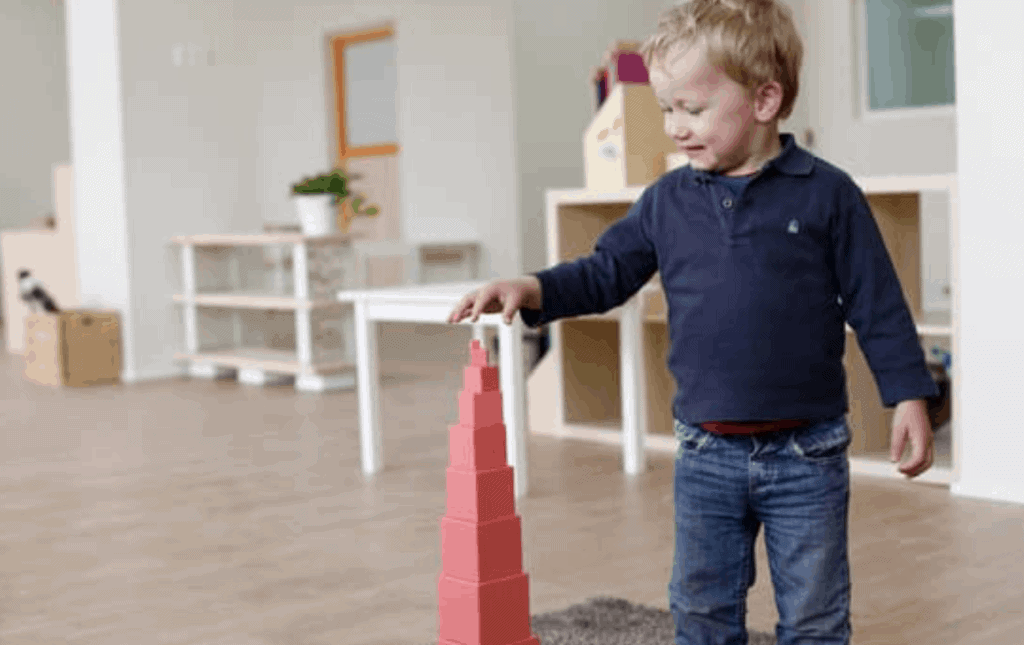
The Brown Stairs
The Brown Stairs introduce the concepts of thick and thin and how they relate spacially in a 3-dimensional world. They consist of 10 brown prisms that vary in height, each ascending by 1 cm, but are the same length. When assembled in order, the prisms create what resembles a staircase.
This exercise not only visually demonstrates depth, but it helps to prepare a child’s mind for more advanced mathematical concepts. Because the smallest prism is 1cm in thickness, adding the smallest prism to the top of another will match its height to the prism next to it.
The Red Rods
Much like the pink tower, the activity is focused on the difference in size. And while The Brown Stairs introduced thickness, The Red Rods concentrate on the concept of length.
There are 10 rods that vary in length from 10cm to 100 cm. Students are encouraged to arrange them in ascending or descending order.

Knobbed Cylinders
This Montessori activity involves a box with four rows of wooden cylinders, all with small attached knobs. Each row consists of 10 knobs and demonstrates a difference in size, utilizing more complicated concepts.
One row of knobs varies in height. The next demonstrates a difference in diameters. Another set of knobs includes different diameters and heights, while the last row increases in diameter while it decreases in height.
The child learns to expand on their concepts of big and small and also practices and develops fine motor skills necessary for removing and replacing the knobs in their appropriate positions.

Color Tablets
Color tablets are wooden tablets that represent color. These are utilized in many ways in
For one, color tablets can be used in boxes of gradient color. For example, you would have boxes of blues, greens, and purples that can be organized from lightest to darkest. This allows children to process the depth and tone of different colors.
Another way color tablets are used is to facilitate the understanding of the law of color. Color tablets can be arranged in boxes featuring the primary colors, a box of primary and secondary colors, and boxes that cover a full-color spectrum.
Activities with these tablets would include matching the same colors, as well as pairing color tablets with their complementary color on the color wheel, or with the primary colors that compose a secondary color.
These skills enforce a child’s ability to define and understand the complex world of color.
Tactile Sense Activities (Touch)
Developing the sense of touch and understanding the physical world around them is a significant factor in healthy childhood development. These activities are designed to help a child explore the world through feeling, mainly with the fingertips of their hands.
Touch Boards
Touch boards are used to introduce smoothness and roughness to children and their varying degrees. Touch boards usually come in 3 sets and are focused on recognizing the difference between smooth and rough.
By using the fingertips only and gently gliding their fingers over the boards, a child is also practicing muscle control while learning about physical, tactile differences.
Touch boards have entirely smooth sections and sections that are covered with sandpaper. The third and more advanced board uses different grit sandpaper to go from roughest to completely smooth.
While the child is running their fingers over the surface of a touch board, the teacher will repeat the language to describe it to a child.
Touch Tablets
Expanding on the lessons from the Touch Boards, Touch Tablets are boxes containing five pairs of wooden tablets. The tablets are covered in sandpaper that can be arranged in order of smoothness or roughness or matched into pairs.
This activity refines a child’s sense of touch and teaches them to recognize small and subtle differences in texture.
Fabric Matching
This fun and unique matching activity is usually done with the child’s eyes shut. Eight to ten matching pairs of fabric squares are placed in a pile.
The squares of fabric must be natural fabrics such as cotton, silk, wool, burlap, denim, chiffon, etc., and that they are properly finished around the edges. This guarantees that the tactile experience within the pairs is identical and that the child can hone in on the exact feeling of the fabric and not frayed or messy ends.
With their eyes closed, give the child a piece of fabric to touch and explore. Then, handing the child another price at a time, encourage them to find the fabric’s match by using their sense of touch alone.
This type of activity encourages children to think of touch in much broader terms and to notice subtle and unique differences in feelings of the fabrics.
Baric Sense Activities (Weight)
The most used sensorial activity to teach baric sense to children in
Children are encouraged to arrange these tablets from lightest to heaviest while noticing that while the tablets may look similar, they may feel or weigh different amounts.
Introducing the concepts of heavy and light tangibly allows children to physically experience and learn weight as it applies to objects in their surroundings.

Thermic Sense Activities (Temperature)
Thermic activities for children explore hot and colder, warmer and cooler, and the relationship with the temperature of the child’s own body.
Two specific activities explore heat and heat conduction for children, while also engaging their tactile sense.
Thermic Bottles
Using pairs of metal containers to hold different temperatures of water, these are meant to be paired into matching temperatures as well as being arranged in lines from coolest to warmest.
The controlled temperature in Thermic Bottles is the child’s body temperature. This pair of bottles is usually marked in a way to differentiate them from the rest.
In increments of 10 degrees, there is usually one bottle that is warmer than the control and two others that are cooler.
By wrapping their palms around the bottles, children can physically experience temperature specifically as it relates to the core temperature of their bodies. This learning will directly allow them to understand how they experience temperature changes around them.
Thermic Tablets
Thermic Tablets are wooden framed tablets that are made up of a variety of materials that are known to conduct heat differently. Tablets made from wood, marble, iron, and felt, for example, are placed out for a child to touch while blindfolded.
Building on the concepts of hot and cold, children are asked to describe the materials they are touching using temperature as their point of focus.
Children can arrange these tablets in various ways, focusing on how warm or cool they appear to them by touch. These also can be linked to other conceptualized learning, such as smooth and rough.

Auditory Sense Activities (Sound)
By using sound boxes and bells, these
Sound boxes are designed to help children discern sound based on loudness. Closed wooden cylinders are used to create different sounds when shaken. Like-cylinders are color-coded to assist the child in organizing and categorizing the sounds from loudest to softest.
While the sound boxes create distinction in the loudness of a sound, Montessori bell exercises teach children to recognize the tonal and pitch differences between a similar sound.
Bells can be used for sound matching as well as ascending and descending sounds in terms of high and low.
Olfactory and Gustatory Activities (Smell and Taste)
Our senses of taste and smell very often work together within the body. However, a key feature in
To do this, activities focused on smell and taste are done using smelling jars and tasting bottles.
Smelling Jars
Opaque bottles are used to make smelling bottles, and just as in every other Montessori activities, they are created in sets with pairs for children to match.
Cotton balls are the bottom of each bottle are coated with various scents like vanilla, lemon, peppermint, coconut, or coffee.
Placing smelling bottles around the room and starting with one bottle, the child is encouraged to explore the bottles around them to locate the matching scent. More advanced activities apply language to help the child describe and determine the characteristics of scents like spices, sweetness, etc.
Tasting Bottles
Four bottles with droppers are created to explore and develop a child’s connection to their sense of taste and familiarize them with the most common ways of categorizing flavors and tastes.
Water is mixed with salt, sugar, lemon, etc., to refine a child’s experience and knowledge of salty, sweet, and sour. Often, tonic water is used as the control for bitterness.
By expanding a child’s experience with their sense of taste, they will be able to identify things they taste in their daily lives immediately.
These activities focus on the proper descriptive language, and as with all other sensorial activities, categorizing and matching.
Stereognostic Sense Activities (Tactile Gnosis/ The “Sixth” Sense”)
The intense development of the tactile sense or the sense of touch within the Montessori method of teaching is impressive.
So much so, that in this particular category, the focus is on a child using only their sense of touch to identify, classify, and make sense of an object. This work speaks to an intuitive use of your sense of touch and builds confidence, intelligence, and independence.
Children practice identifying characteristics of objects and objects themselves without the use of sight, sound, smell, or taste.
The Painted and Sandpaper Globes
Painted globes and sandpaper globes are used to teach children continents and oceans while refining and reinforcing concepts like smooth and rough.
By feeling only, children are encouraged to locate the large, outlined land masses on a painted globe, or large and rough land masses on a sandpaper globe.
Feeling around the smooth, large bodies of water and identifying them as oceans create a visual of the Earth in the child’s mind that can depict the world as accurately as the globe itself, all while only using their sense of touch.
Encourage the child to locate all of the continents and the divided bodies of water.

Mystery Bags
One of the most basic and accessible ways to engage children in this category of activities is with mystery bags.
Place ten objects in 10 opaque, dark bags. Allow the child to touch the object and encourage him to describe its features. Is it soft or hard? Does the item feel heavy? Is it rough? Discuss the shape of the object and have the child guess what the object might be.
Examples of objects to place in mystery bags might be cotton balls, buttons, pine cones, a spoon, or a comb.
Being able to identify objects by exploring their physical features using touch forms connections in the brain and plant the seeds for logical and critical thinking skills and problem-solving abilities.
The sensorial work developed and perfected by Maria Montessori is designed to develop healthy, happy children into confident, independent adults. Sensorial work allows children to build critical skills and practical relationships with the world around them.
By introducing complex and abstract ideas to young children in tangible and experiential ways, sensorial work creates the foundation for all further academic pursuits. Providing sensory education is the greatest gift anyone could bestow upon their children.



